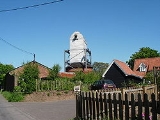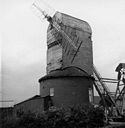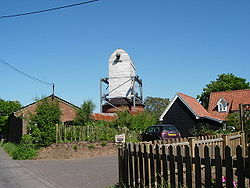
Friston Windmill
Encyclopedia
Friston Windmill is a Grade II* listed post mill
at Friston
, Suffolk
, England
which has been conserved.
by Collins, the Melton
millwright
in 1812 and erected on land purchased by William and Mary Scarlett. They sold the mill to Joseph Collings in 1812. The mill was worked by several different millers until 1837 when it was purchased by Joshua Reynolds from Knodishall
. The mill passed to Caleb Reynolds Wright in 1883 and to his son Caleb Reynolds Wright Jr. in 1924. A pair of sails was removed in 1943 and not replaced due to the shortage of timber. The mill worked on two sails until 1956 and then by a diesel engine
until 1964.
In 1965, permission
was granted for the demolition of the mill but this was not carried out. Due to changes in planning law, permission had to be sought again in 1968. Villagers were divided as to whether the mill should be kept or demolished and there was much debate in the local newspapers. A millwright was asked to inspect the mill and the decision was deferred for a month. The millwrights’ report showed that the mill was structurally sound and it was agreed in principle that the mill should be moved to the East Anglian Rural Life Museum
at Stowmarket
, where plans for the museum included a windmill. Meanwhile, money was raised locally and repairs started on the mill in 1971. Permission for demolition was rescinded and on the death of the last miller in 1972 a new owner bought the mill with the intention of preserving it. In 1977, the body of the mill was restored by Messrs Jameson Marshall, millwrights.
In 2003, English Heritage
gave a grant covering 20% of the cost of repairs which then needed doing to the mill. In 2004, it was announced that a steel framework was to be erected around the mill in order to allow work on the trestle
and body of the mill.
 Friston Windmill is a tall post mill with a roundhouse. It had four Patent sails
Friston Windmill is a tall post mill with a roundhouse. It had four Patent sails
and was winded by a fantail
carried on the rear steps in the Suffolk style. The mill is 50 feet (15.24 m) high, making it the tallest surviving post mill in the United Kingdom. The mill has been preserved but the three pairs of millstone
s have been removed. The mill had two pairs of millstones in the breast and one pair in the tail.

Reference for above:-
Post mill
The post mill is the earliest type of European windmill. The defining feature is that the whole body of the mill that houses the machinery is mounted on a single vertical post, around which it can be turned to bring the sails into the wind. The earliest post mills in England are thought to have...
at Friston
Friston
Friston is a village in Suffolk, England. It is southeast of Saxmundham, its post town, and northwest of Aldeburgh. The River Alde bounds the village on the south. The surrounding land is chiefly arable. The soil becomes partly marshy in the lower grounds...
, Suffolk
Suffolk
Suffolk is a non-metropolitan county of historic origin in East Anglia, England. It has borders with Norfolk to the north, Cambridgeshire to the west and Essex to the south. The North Sea lies to the east...
, England
England
England is a country that is part of the United Kingdom. It shares land borders with Scotland to the north and Wales to the west; the Irish Sea is to the north west, the Celtic Sea to the south west, with the North Sea to the east and the English Channel to the south separating it from continental...
which has been conserved.
History
Friston Windmill was moved from WoodbridgeWoodbridge, Suffolk
Woodbridge is a town in Suffolk, East Anglia, England. It is in the East of England, not far from the coast. It lies along the River Deben, with a population of about 7,480. The town is served by Woodbridge railway station on the Ipswich-Lowestoft East Suffolk Line. Woodbridge is twinned with...
by Collins, the Melton
Melton, Suffolk
Melton is a village in Suffolk, England, located approximately one mile north east of Woodbridge. The 2001 census recorded a population of 3718. The village is served by Melton railway station on the Ipswich-Lowestoft East Suffolk Line....
millwright
Millwright
A millwright is a craftsman or tradesman engaged with the construction and maintenance of machinery.Early millwrights were specialist carpenters who erected machines used in agriculture, food processing and processing lumber and paper...
in 1812 and erected on land purchased by William and Mary Scarlett. They sold the mill to Joseph Collings in 1812. The mill was worked by several different millers until 1837 when it was purchased by Joshua Reynolds from Knodishall
Knodishall
Knodishall is a village in Suffolk, England. The village is located southeast of Saxmundham and southwest of Leiston, its post town. Most of the village is now in Coldfair Green, with only a few houses remaining in the original village by the parish church of St Lawrence.-Community:The village...
. The mill passed to Caleb Reynolds Wright in 1883 and to his son Caleb Reynolds Wright Jr. in 1924. A pair of sails was removed in 1943 and not replaced due to the shortage of timber. The mill worked on two sails until 1956 and then by a diesel engine
Diesel engine
A diesel engine is an internal combustion engine that uses the heat of compression to initiate ignition to burn the fuel, which is injected into the combustion chamber...
until 1964.
In 1965, permission
Planning permission
Planning permission or planning consent is the permission required in the United Kingdom in order to be allowed to build on land, or change the use of land or buildings. Within the UK the occupier of any land or building will need title to that land or building , but will also need "planning...
was granted for the demolition of the mill but this was not carried out. Due to changes in planning law, permission had to be sought again in 1968. Villagers were divided as to whether the mill should be kept or demolished and there was much debate in the local newspapers. A millwright was asked to inspect the mill and the decision was deferred for a month. The millwrights’ report showed that the mill was structurally sound and it was agreed in principle that the mill should be moved to the East Anglian Rural Life Museum
Museum of East Anglian Life
The Museum of East Anglian Life is a Museum located in Stowmarket Suffolk, it specialises in presenting the agricultural history of East Anglia through a mixture of exhibits and living history demonstrations. It has recently taken to abbreviating itself as 'MEAL'.-History of the Museum:The site of...
at Stowmarket
Stowmarket
-See also:* Stowmarket Town F.C.* Stowmarket High School-External links:* * * * *...
, where plans for the museum included a windmill. Meanwhile, money was raised locally and repairs started on the mill in 1971. Permission for demolition was rescinded and on the death of the last miller in 1972 a new owner bought the mill with the intention of preserving it. In 1977, the body of the mill was restored by Messrs Jameson Marshall, millwrights.
In 2003, English Heritage
English Heritage
English Heritage . is an executive non-departmental public body of the British Government sponsored by the Department for Culture, Media and Sport...
gave a grant covering 20% of the cost of repairs which then needed doing to the mill. In 2004, it was announced that a steel framework was to be erected around the mill in order to allow work on the trestle
Trestle (mill)
The Trestle of a Post mill is the arrangement of the Main post, crosstrees and quarterbars that form the substructure of this type of windmill. It may or may not be surrounded by a roundhouse...
and body of the mill.
Description

Windmill sail
Windmills are powered by their sails. Sails are found in different designs, from primitive common sails to the advanced patent sails.-Jib sails:...
and was winded by a fantail
Windmill fantail
A Fantail is a small windmill mounted at right angles to the sails, at the rear of the windmill, and which turns the cap automatically to bring it into the wind. The fantail was patented in 1745 by Edmund Lee, a blacksmith working at Brockmill Forge near Wigan, England, and perfected on mills...
carried on the rear steps in the Suffolk style. The mill is 50 feet (15.24 m) high, making it the tallest surviving post mill in the United Kingdom. The mill has been preserved but the three pairs of millstone
Millstone
Millstones or mill stones are used in windmills and watermills, including tide mills, for grinding wheat or other grains.The type of stone most suitable for making millstones is a siliceous rock called burrstone , an open-textured, porous but tough, fine-grained sandstone, or a silicified,...
s have been removed. The mill had two pairs of millstones in the breast and one pair in the tail.
Millers

- William and Mary Scarlett 1812
- Joseph Collings 1812 –
- Robert Reynolds 1850s
- John Reynolds 1850s
- Joshua Reynolds 1850s – 1883
- Caleb Reynolds Wright 1883 – 1924
- Caleb Reynolds Wright Jr. 1924 – 1964
Reference for above:-
External links
- Windmill World webpage on Friston mill.

